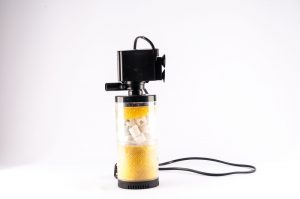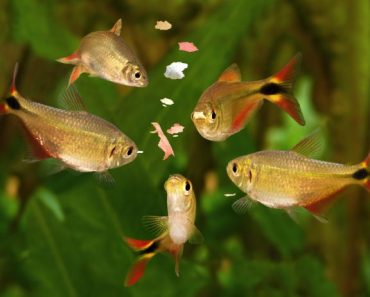 With their magical and unique effects, aquariums enchant us humans and let us create an underwater world fit for dreaming. Because of the fishes’ and plants’ metabolism as well as food waste etc., there is quickly much waste inside the aquarium that has to be recycled.
With their magical and unique effects, aquariums enchant us humans and let us create an underwater world fit for dreaming. Because of the fishes’ and plants’ metabolism as well as food waste etc., there is quickly much waste inside the aquarium that has to be recycled.
This waste not only impacts visibility and destroys the optical impact, it also has a negative influence on water values so that in a worst case scenario, poisonous material can build up. These poisonous materials can lead to the death of all inhabitants in either a short or long term scenario. For this reason it is not only important to change the water in a regular manner but also keep it constantly filtered. This article will present to you different kinds of filters and how this important part of technical equipment of an aquarium works.
Contents
Task of an aquarium filter
As you can see from its name, an aquarium filter’s main task is to filter and clean the water. In this way, all waste is filtered out. It does not matter if it is a waste from plants or fish feces, an aquarium filter, selected to fit the aquarium, keeps the water clean and leads to good and stable water values. However there are different kinds of filters, which filter the water in different ways.
Besides filtering, most aquarium filters also get the water moving, which is a result of sucking the water in and letting the clean water flow out again. This is also important, since many fishes and plants need a natural water flow. Some filters even offer a setting for the strength of the flow, so it can be customized to the aquarium’s inhabitants.
Besides the filter, plants are also responsible for neutralizing poisonous substances from the water, so there should always be enough plants in an aquarium. Only in this way the biological balance can be kept.
Which kind of filter is fit for which kind of aquarium?
 Since there are many different kinds of possibilities for filters, it is not an easy task to decide for any one method. For this reason you should get to know the various methods. When choosing a new aquarium filter, you should watch out for multiple criteria. On the one hand the material the filter is made of plays an important role and has to be fitting for the needs and requirements of your fish. On the other hand, some filter systems are only fit for certain aquarium sizes or designs. In this way, no small filter fit for aquariums of only 100 liter volume should be used for a big tank of 800 liters of volume. So the volume of the aquarium always has to be fit for the filter volume. What kinds of filters are there? There are different filter types, all with the same purpose: filtering the aquariums water in a reliable manner.
Since there are many different kinds of possibilities for filters, it is not an easy task to decide for any one method. For this reason you should get to know the various methods. When choosing a new aquarium filter, you should watch out for multiple criteria. On the one hand the material the filter is made of plays an important role and has to be fitting for the needs and requirements of your fish. On the other hand, some filter systems are only fit for certain aquarium sizes or designs. In this way, no small filter fit for aquariums of only 100 liter volume should be used for a big tank of 800 liters of volume. So the volume of the aquarium always has to be fit for the filter volume. What kinds of filters are there? There are different filter types, all with the same purpose: filtering the aquariums water in a reliable manner.
The mechanical filter
A mechanical filter filters the coarse as well as the fine waste out of the aquarium’s water. It is suited as a pre-filter as well as a complete filter system. All models are great because of the easiness of changing the filter material and are easy to install and remove. In a freshwater tank, the rate of minimum flow should be up to the quadruple of the water volume.
In a seawater tank, it should at least be the tenfold amount. For this reason, many fish enthusiasts change the filter substrate every week, which leads to the impossibility of the mechanical filter being used as a biological filter because important bacteria are destroyed when cleaning it. An optimal kind of mechanical filter is the interior engine filter, of which there are various different types.
Trickle filter
Trickle filters are rather rare. They work in a way that is called “super-aerobe”. In this way, water is applied to the filter material, which of course has an air contact and is directed into a seperate tank. From this tank it is pumped back into the aquarium. Trickle filters only work effectively if at least 4,000 liters of water in an hour flow through it, which is rarely the case.

Anaerobic filters
An anaerobic filter is a great method of biological filtering. This filter works without any oxygen. In such a model, the filter material has to be surrounded by water low in oxygen, which is only possible with a slow flow of water. If the water flows through very slowly, oxygen is completely gone after only a couple of centimeters in the filter bed. In contrast to other filter models, only nitrate is broken down, so proteins etc. cannot be changed to nitrate and broken down afterward. For this reason, these filters can only be used as an addition and are not fit to be used on their own.
Biological filters
With these unique filters, bacteria living inside the filter are responsible for cleaning the water. Millions of small organisms, bacteria, amoeba and ciliates among others, live in these filters and feed off the organic material inside the water. This organic material is either removed or reformed in a way that it can be added back to the water. The bacteria and other organisms can be seen on the filter material as a brown mud. So it is important not to wash them off, since they aid the aquarium, providing enough water flows through the filter and does not block it off. Proteins, fats and carbohydrates, all parts of the aquarium water, are the main source of food for these micro-organisms. They are changed into nitrate and carbon dioxide. The biological filter is fit for any kind of aquarium.
Exterior filter
This filter is installed outside of the aquarium and does not disturb the optical impression. Water is transported to the filter through tubes, often available in different sizes. The filter typically is located in the aquarium’s floor unit. Water flows through the filter there, typically filled with various kinds of filter materials, and is filtered. The filter material should be chosen depending on the aquarium’s inhabitants. After cleaning, the water is pumped back into the aquarium, leading to water movement. Exterior filters are great because they do not take away space inside the tank and do not impact the appearance either.
Interior filter
Beside exterior filters, there are of course also interior filters. These suck in the water, clean it by leading it through a chosen filter material and return the water afterward. Interior filters have the advantage that they do not need any kind of tubes. They can be used for creating water flow and are available in many sizes. Some models work solely as aerobic filters but there are also models which filter one part of the water anaerobic and one part aerobic. A disadvantage is of course that they need some space and have to be removed from the tank every time you clean them.
Conclusion
No matter for which type of filter you decide, it is important to watch out for an appropriate size. Better take a model that is a bit too large and cleans more water than for the one that cannot keep up with the amount of water your aquarium holds. Additionally it is important to keep up with the individual filter’s requirements and attributes so they do not break easily, have a long life and always keep your aquarium water clean in a reliable manner.
Fotocredit: © FamVeld – shutterstock.com / © FamVeld – shutterstock.com




